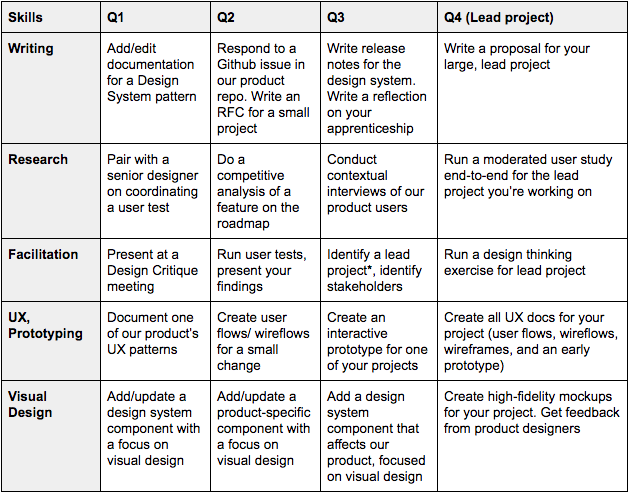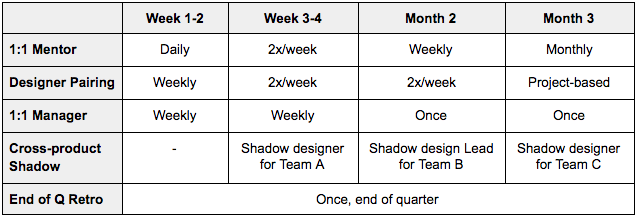Last year, our first Product Design Apprentice went through our program at HashiCorp. Now that she’s been promoted to Product Designer, we can reflect on our process and give insight to other organizations considering a similar program.
About Apprenticeships
Let’s start with the basics. An apprentice is someone being paid to work under the guidance and training of a skilled, experienced person in a particular craft. Since the Middle Ages, apprentices have been a part of various career cultures, from seam-stressing to carpentry. Today’s industries often have job opportunities that sound like apprenticeships, such as vocational training, but many of them tend to fall short of the mutual relationships and artisanship that the term “apprentice” connotes.
Above all things, an apprenticeship is not an internship. An apprenticeship is an intentional program built around mentorship (not management), real work (no coffee runs), and a salary (you are valued).
An apprenticeship is also not an assistant for hire. If you need an extra hand to do mostly menial tasks, how would the apprentice level up? If you need an extra hand because you have too much work, will you have time to mentor an apprentice gradually before they are thrown into complex projects?
Why We Built the Program
Briefly, here are a few reasons why we decided to create the design apprenticeship program at HashiCorp.
Create Mentorship Opportunity
Our team is made up of mostly senior product designers. While it’s an incredible set of people to learn from, we didn’t have an avenue for formal mentorship opportunities. Some members of the team wanted an opportunity to learn those types of skills without having to go down the full on “management track.”
Increase Efficiency
With extra hands around, we can get more done. But after a year of nearly constant interviewing (HashiCorp has nearly doubled in size in a year), we learned that hiring senior designers takes a lot of time and care. That’s important and won’t change. But there’s also a massive pool of amazing, motivated junior candidates with tons of potential who are ready to join a team — a team that is also ready to support them.
Provide Rare, Remote, Junior Role
As a completely remote, distributed team, HashiCorp can share a truly unique opportunity. Most companies large enough to offer an apprenticeship program are located in the major tech cities of America. That’s great for junior designers who went to an urban college, have a cousin working at Big Tech Company, or interned at Trendy Design Studio. This opportunity isn’t for those folks.
When we set out to hire an apprentice, we recognized that we had the unique privilege of working with someone living in a rural location, someone parenting on their own, or someone who works at home because of an illness or a family member’s disability.
There are so many reasons why people want to work remotely, and it doesn’t have to be an opportunity limited to the senior software engineers able to negotiate it.
Because of that, we felt this program could lead to more diverse backgrounds on the design team. Apprenticeships can’t be the only avenue for strengthening a team’s diversity, but it’s one more way to hire from an increased pool of underrepresented minorities.
How We Hired for the Role
We looked for people with a portfolio of product design work, most likely projects assigned at school or self-directed learning programs. Even if there weren’t many “real” projects on their websites, we looked for candidates that generally understood design phases and could communicate their thoughts clearly and efficiently. The designs should have shown strong potential, but didn’t need to be perfect by any means.
With that in mind, we figured the most appropriate applications would come from recent school graduates (bootcamps, colleges, online programs) and/or people transitioning into product design from other careers.
We did not consider student candidates in the middle of high school or college. Our program is a full-time role with no end date, not a summer job. We also turned away candidates applying to any tech role — engineering or product management, for example. We wanted someone keenly interested in design, not just any job in tech. Finally, we did not consider mid-level designers applying to jobs beneath their level. Believe in yourself! Apply for a full on Product Design role, not an apprenticeship.
What Our Program Looks Like
The goal of our Apprenticeship Program is to mentor the apprentice into a “Level 1” Product Designer (HashiCorp has five “levels” in our product design career ladder).
To do this, the apprentice is working closely with a senior designer (myself), embedded on one of our product teams (Consul). The senior designer is the apprentice’s official mentor, and they work together to create goals and identify projects that can be done to reach those goals and progress through the career matrix.
Career Matrix & Goals
Product designers at HashiCorp benefit from a documented, transparent career ladder. It specifies the skills and behaviors that we expect from each of the five “levels” of product designer.
In that vein, we worked with the product design apprentice to ensure each milestone in their year-long plan leads directly to the skills by which we determine a Level 1 designer. Below is an example table of goals (our actual table was more detailed, with links to Asana, Github, docs, etc.). Experience across these areas should lead the apprentice to levelling up in the ways we expect.

An apprenticeship program with specific, documented milestones that lead toward the first level of a transparent career ladder accomplishes all of the following:
- Gives the apprentice a clear idea of what they’re working toward
- Sets expectations in a manner consistent with how you set expectations for the rest of the team
- Encourages more autonomy in the apprentice, serving as a compass for where they need to grow from Day 1
- May provide awareness to the employer of how much support they will truly need to provide to level up an apprentice within the expected timeframe
- Gives all parties a document to return to for check-ins, ensures expectations are being met on both sides, and provides talking points if those expectations are not being met
The apprenticeship plan is one of the most important factors in success. You cannot rely on the best of intentions. Both the employer and the apprentice benefit from a robust, thoughtful plan that is intentional, transparent, and well-documented.
Timeline
In our partnership with the apprentice, we aim for them to become a “Level 1” Product Designer in one year’s time. Our framework specifies a timeline goal so that it isn’t completely nebulous, but it also isn’t overly rigid, leaving wiggle room for slightly different speeds of learning and growth. With a different apprentice, we might specify a different timeframe. Like any other role, we may also decide to part ways if a permanent role is no longer available or if, in the end, it simply isn’t the right fit.
Collaboration Agenda
We wanted to create expectations for check-ins during the first quarter, but not plan so far ahead that we couldn’t pivot after trying things out the first 3 months.

A few things to note when looking at this table:
- At the beginning, the “mentor” and “manager” for this apprentice were distinct people, hence why we had separate meeting schedules. Halfway through, their mentor became their manager, and took over those 1:1s.
- The cross-product shadow was proven to be so valuable, that we decided to implement cross-product pairing for our whole design team.
After Q1, we edited this agenda slightly (above is an edited version), based on what was working well and what needed a change. We then followed the edited agenda for Q2.
What’s Next?
For this apprenticeship, we ended up hiring Jasmine Wright from Augusta, Georgia, who had gone through an online bootcamp focused on design while working as a web developer for a university website. Mentoring Jasmine has been a breeze; she is both mellow and motivated, thoughtful and growth-minded. We are lucky to have her on our staff as a Product Designer for our Consul product.
Next up, Jasmine would love to share her insights from the apprenticeship and tips for junior designers.








